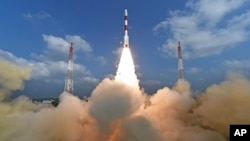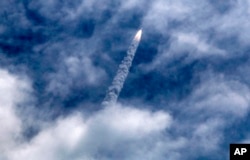An Indian rocket blasted off Wednesday morning from Sriharikota in eastern India putting a record 104 satellites into space in a single launch, surpassing Russia’s previous feat of launching 37 satellites one year ago, according to India’s space agency.
The launch also marked a milestone in the country’s efforts to emerge as a serious contender in the multi-billion dollar global commercial space industry by slashing costs.
Besides a 714 kilogram earth observation satellite, the others were mostly nano satellites — those weighing up to 10 kilograms. A majority of these small satellites came from customers in the United States, others from countries such as Kazakhstan, the Netherlands, Switzerland and the United Arab Emirates.
The nationally televised launch showed scientists applauding successive stages in the mission control room.
Calling it a “great moment” for the Indian Space Research Organization, Associate Project Director B Jayakumar said, “as you know doing something new in an innovative way, successfully is always a passion for ISRO people.”
Low-cost program
India’s space program has focused heavily on low-cost access to space. The ability to put a larger number of satellites in space in a single launch brings down the cost significantly, which could help the country grab a larger slice of the commercial launch market, analysts say.
“Doing record-breaking launches in one go does clearly highlight India’s advancement as well as the sophistication to do a lot more maneuvering in India’s space program,” said Rajeswari Pillai Rajagopalan, a space analyst from New Delhi’s Observer Research Foundation. Pointing out that it will inspire more confidence in India’s space program, she said “A lot many more countries could be approaching India to do their own space launches.”
The growing demand for more high-tech communication by countries, as well as by private telephone, Internet and other companies, has hugely boosted the demand for such launches. Last year, India launched 75 satellites for foreign customers.
Prime Minister Narendra Modi tweeted “This remarkable feat by ISRO is yet another proud moment for our space scientific community and the nation. India salutes our scientists.”
India increased the budget for its space program this year and allocated resources for a potential second mission to Mars and its first to Venus in the coming years.
Mars mission
India’s ambitious space program got international attention after a successful mission to Mars in 2014, whose price tag of $74 million, compared to $670 million outlay of NASA’s Mars mission a few months later, was hailed as an indication that its frugal space program has achieved technological prowess.
ISRO plans to send a second mission to study the surface of the Moon next year and is also eyeing a second mission to Mars and its first to Venus in the years to come.
Many see India’s foray into interplanetary missions as part of its ambitions to be seen as one of the world’s leading countries.
“One of the factors is also Asian nationalism and the competition. There are also lot of things being planned to also show that India is an advanced technology power in this regard,” said Rajagoplanan.
While India has developed the capability of putting smaller satellites in space, it still has some way to go before it can launch heavier ones, according to scientists.












